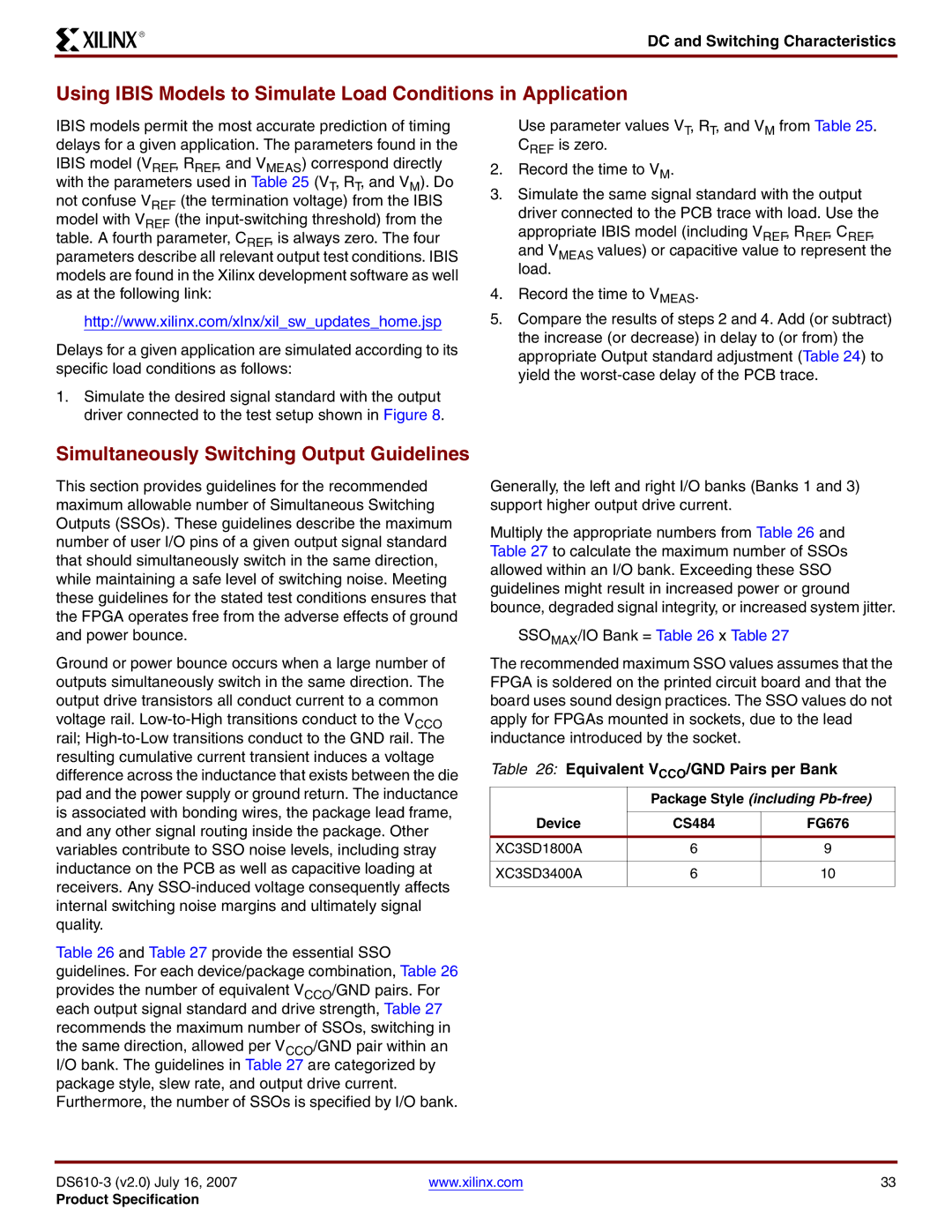
R
DC and Switching Characteristics
Using IBIS Models to Simulate Load Conditions in Application
IBIS models permit the most accurate prediction of timing delays for a given application. The parameters found in the
IBIS model (VREF, RREF, and VMEAS) correspond directly with the parameters used in Table 25 (VT, RT, and VM). Do
not confuse VREF (the termination voltage) from the IBIS model with VREF (the
http://www.xilinx.com/xlnx/xil_sw_updates_home.jsp
Delays for a given application are simulated according to its specific load conditions as follows:
1.Simulate the desired signal standard with the output driver connected to the test setup shown in Figure 8.
Use parameter values VT, RT, and VM from Table 25. CREF is zero.
2.Record the time to VM.
3.Simulate the same signal standard with the output driver connected to the PCB trace with load. Use the
appropriate IBIS model (including VREF, RREF, CREF, and VMEAS values) or capacitive value to represent the load.
4.Record the time to VMEAS.
5.Compare the results of steps 2 and 4. Add (or subtract) the increase (or decrease) in delay to (or from) the appropriate Output standard adjustment (Table 24) to yield the
Simultaneously Switching Output Guidelines
This section provides guidelines for the recommended maximum allowable number of Simultaneous Switching Outputs (SSOs). These guidelines describe the maximum number of user I/O pins of a given output signal standard that should simultaneously switch in the same direction, while maintaining a safe level of switching noise. Meeting these guidelines for the stated test conditions ensures that the FPGA operates free from the adverse effects of ground and power bounce.
Ground or power bounce occurs when a large number of outputs simultaneously switch in the same direction. The output drive transistors all conduct current to a common voltage rail.
Table 26 and Table 27 provide the essential SSO guidelines. For each device/package combination, Table 26 provides the number of equivalent VCCO/GND pairs. For each output signal standard and drive strength, Table 27 recommends the maximum number of SSOs, switching in the same direction, allowed per VCCO/GND pair within an I/O bank. The guidelines in Table 27 are categorized by package style, slew rate, and output drive current. Furthermore, the number of SSOs is specified by I/O bank.
Generally, the left and right I/O banks (Banks 1 and 3) support higher output drive current.
Multiply the appropriate numbers from Table 26 and Table 27 to calculate the maximum number of SSOs allowed within an I/O bank. Exceeding these SSO guidelines might result in increased power or ground bounce, degraded signal integrity, or increased system jitter.
SSOMAX/IO Bank = Table 26 x Table 27
The recommended maximum SSO values assumes that the FPGA is soldered on the printed circuit board and that the board uses sound design practices. The SSO values do not apply for FPGAs mounted in sockets, due to the lead inductance introduced by the socket.
Table 26: Equivalent VCCO/GND Pairs per Bank
| Package Style (including | |
|
|
|
Device | CS484 | FG676 |
XC3SD1800A | 6 | 9 |
|
|
|
XC3SD3400A | 6 | 10 |
|
|
|
www.xilinx.com | 33 |
Product Specification
